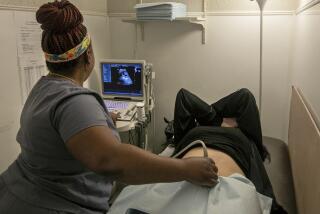Tools to Calm --or Warn--Parents-to-Be
- Share via
For most expecting families, few experiences match the first glimpse of the baby through an ultrasound. For women, it’s often a sign that the baby is fine. For fathers, it’s sometimes the first concrete evidence that they are pegged for fatherhood. But as technology improves, ultrasounds are becoming more the diagnostic device they were intended to be, and parents are sometimes left stunned by the outcome.
Illina and Ed Maningo went in for an ultrasound when she was seven months pregnant with their second child. They went expecting a soothing look at their normal baby. Instead, the test vaulted them into shock and disbelief.
Illina admitted, “It wasn’t very joyous.”
Her obstetrician, after suspecting a problem, sent them to a radiologist, who told them the baby probably had a cleft lip and palate.
“I could see it in the ultrasound,” Illina said. The baby had given them a rare look at his face.
“Of course, you’re going to freak out,” she said. “The first thing I was thinking was, is there anything else wrong with him?”
A cleft lip and palate, caused by the failure of the parts of a cleft to grow together, also can be associated with heart or brain damage. The Long Beach couple learned everything they could about the condition. They found a cosmetic surgeon. They prepared their close family and friends. In the middle of asking “Why did this happen?” they discovered an adult cousin of Ed’s had a cleft palate that had been corrected. “We had met her once and didn’t know,” Illina said.
By the time Joshua was born, a plastic surgeon had walked his parents through the types of corrective surgery available. The Maningos changed hospitals so Illina could deliver at Miller’s Children, the pediatric arm of Long Beach Memorial Medical Center, where a team of doctors was present to diagnose and help her baby.
Illina said knowing ahead of time helped prepare her for the initial hardships. Children with cleft lips and palates have difficulty feeding, and Joshua had to spend some time in intensive care.
And she says she was able to bond with him completely--a process, she has since learned, that can be stunted when a mother is faced with a baby with an unexpected problem.
Except for a cleft lip and palate, Joshua was normal. Illina thought, “It’s only cosmetic; it’s fixable.”
Joshua had his first surgery in December. He will have seven more throughout his childhood. “He’s so cute now,” said his mother. “He’s just so very smart.”
An Accepted Standard for 10 Years
Ultrasounds, which create a picture of the fetus by beaming harmless sound waves into the body and reflecting them on a monitor, have been the standard of care for pregnant women for the last 10 years. But medicine is increasingly viewing ultrasounds as an important window to a baby’s health. Indeed, two local medical centers are participating in a study to screen for Down syndrome through ultrasound and a test of a mother’s blood.
“Everyone has agreed for more than 10 years that if an ultrasound is clinically indicated, you do it,” said Dr. Frank A. Chervenak, chief of Maternal / Fetal Medicine at the New York Hospital-Cornell Medical Center. Chervenak is co-editor of a new report on ultrasound.
About 26 conditions define a “high-risk” pregnancy, including the age of the mother, the uterus size and the number of babies.
But, Chervenak said, even with low-risk women, “your risk of having a child with an anomaly . . . is 2 to 3%. That’s pretty high.”
Chervenak’s study, called “Ultrasound Screening For Fetal Anomalies: Is It Worth It?,” examined routine ultrasound screening in 14 European countries and found that 61% of structural anomalies were detected by ultrasound. This finding contrasts sharply with a 1993 National Institutes of Health study that found only 35% of structural anomalies were detected.
The discrepancies in the two studies could be because of “tremendous unevenness in this country in the quality of ultrasound being performed,” said Chervenak, whose study was published in the Annals of the New York Academy of Sciences.
Ultrasounds are best performed between 18 to 20 weeks of pregnancy, he said. Done properly, they can help diagnose hydrocephalus, spina bifida, bowel problems, heart problems, skull deformities, and cleft palate and lip.
An ultrasound, says Chervenak, can reveal structural abnormalities, while amniocentesis diagnoses chromosomal abnormalities.
Ultrasounds showing defects can lead to early action: sometimes in utero surgery; medical treatment for the mother, such as drugs, extra oxygen and bed rest; mental preparation for the family; and, at times, delivering at a hospital with a full neonatal team.
Of course, most ultrasounds do show a healthy baby. That is what most parents expect, and Chervenak argued that’s reason enough to do one. “The great good we do for most patients is reassurance, which is invaluable. . . . In this day of financial restraint, doctors need to be advocates for their patients and fight for this as an option for them.”
A separate study at the University of Michigan attests to the psychological value of ultrasound. A study at the university’s medical center found 95% of women thought it was important to have an ultrasound, so important that 42% were willing to pay at least $200 for one. Most of the women--83%--said they would worry less if an ultrasound was normal.
“This study confirms that women want ultrasound for their normal, healthy routine pregnancies,” said UM researcher and radiologist Ella Kazerooni.
Women want ultrasounds so they’ll be reassured, yet insurance companies see the exams as serious business: a medical necessity that may yield important information on the baby’s health. Disputes with insurance companies over whether ultrasound is warranted, Chervenak said, come with “the so-called ‘low-risk’ woman.”
“We don’t technically put limits on ultrasounds,” said Phil Soucheray, spokesman for Minneapolis-based United HealthCare Corp. “It’s subject to review to some extent to make sure that it’s medically necessary.”
Not Every Problem Can Be Detected
Ultrasound is not an exact science, said Dr. Lawrence D. Platt, president-elect of the American Institute of Ultrasound in Medicine and chairman of the obstetrics and gynecology department at Cedars-Sinai Medical Center. “Even in the best of hands, there’s a certain percentage of malformations that are missed.”
According to the Centers for Disease Control and Prevention, about 63% of women who gave birth in June got an obstetric ultrasound during pregnancy.
The Maningos, while typical of other families in that they expected a routine exam, experienced the true value of ultrasound.
Plastic surgeon James Wells of Miller’s Children saw a calmness and acceptance in the young couple that he had never seen in 24 years of dealing with families of children with birth defects. “I just saw them as a much more relaxed couple. The anxiety level was totally different.”
Wells visited the couple the afternoon after Joshua’s birth. Having the news ahead of time was crucial, he said. “It made everything much more palatable and much more acceptable to them.”
Still, families pin exalted dreams on the birth of a child and any problem can be emotionally loaded right after birth, he said. A family surprised by a birth defect has a tough emotional journey ahead.
Wells sees ultrasounds as a way to help parents prepare for any kind of deformity--”to help them accept something that Mother Nature has altered.”
More to Read
Sign up for Essential California
The most important California stories and recommendations in your inbox every morning.
You may occasionally receive promotional content from the Los Angeles Times.













![Vista, California-Apri 2, 2025-Hours after undergoing dental surgery a 9-year-old girl was found unresponsive in her home, officials are investigating what caused her death. On March 18, Silvanna Moreno was placed under anesthesia for a dental surgery at Dreamtime Dentistry, a dental facility that "strive[s] to be the premier office for sedation dentistry in Vitsa, CA. (Google Maps)](https://ca-times.brightspotcdn.com/dims4/default/07a58b2/2147483647/strip/true/crop/2016x1344+29+0/resize/840x560!/quality/75/?url=https%3A%2F%2Fcalifornia-times-brightspot.s3.amazonaws.com%2F78%2Ffd%2F9bbf9b62489fa209f9c67df2e472%2Fla-me-dreamtime-dentist-01.jpg)